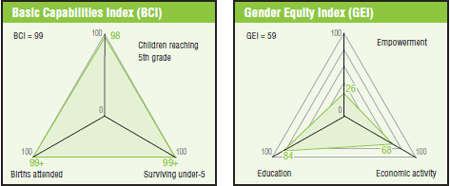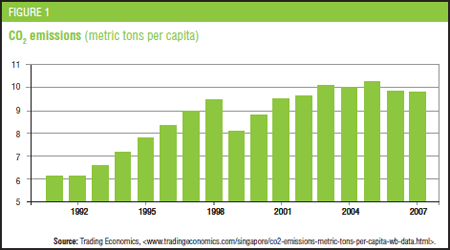The Government’s narrow conception of green
Citizens' Coalition for Economic Justice
Kyehyun Ko
The Government’s plans for economic growth have no regard for social or environmental issues. Its favouring of a neo-liberal model fails to take into consideration the distribution of wealth, the well-being of natural ecosystems or civil society participation. Meanwhile the economy is more and more dependant on foreign markets and investors. The country is failing to provide a minimum standard of living for the poorer sectors of society, a proper welfare system for senior citizens, adequate childcare facilities or a functioning public health system.
 |
There are at least two main obstacles to sustainable development in the Republic of Korea: a high dependence on an economic model based on exports and a weak social welfare infrastructure. According to a 2010 report the country has the most highly dependent on exports and imports among the G20, with exports accounting for 43.4% of its gross domestic product (GDP).[1] The same study stated that it is also the most highly dependent on foreign investment among G20 countries (88%). President Lee Myung-bak’s administration in particular has no concern for anything other than the economic needs of big company owners.
The Government’s obsession with boosting the export sector has caused deep inequality between large and small or medium-sized businesses. The economy is dominated by a few conglomerates such as Samsung and Hyundai, and the gap between them and their suppliers is increasing. While big conglomerates form the backbone of the country’s economy (e.g., Samsung alone provides 20% of exports), small- and medium-sized enterprises provide jobs for more than 80% of the labour force so their health is crucial to the economy. Yet the number of small companies is decreasing. [2] Among them 46% are subcontractors that have neither their own capital nor independent technology and are therefore subordinate to the big companies.
Growing inequalities
 |
This situation has led to increasing social and union unrest and also weak domestic demand due to the increasing numbers of non-regular workers and the unemployed. There is a high prevalence of informal or non-regular workers among the small- and medium-sized companies. The country’s unemployment rate for 2011 rose from 3.6% in January to 4% in February, according to figures from the Government Statistics Department.[3] Unemployment rates are higher among young people (8.5%), with 50% of recent college graduates failing to find a job .
The income gap between informal and formal workers is growing. In 2010 2.1 million workers had earnings below the minimum wage (USD 767 per month).[4] The quarterly Engel’s coefficient (the percentage of food consumption to total spending) posted the highest figure in seven years at 13.92%.[5] Engel found that the lower a family’s income, the greater proportion food expenses account for in its household budget. An increasing coefficient suggests greater impoverishment and growing inequality between rich and poor.
Environmental issues
One of the country’s main environmental concerns is air pollution in the major cities (83% of the population live in urban areas).[6] Sewer discharge and industrial effluents have caused water pollution, including in the form of acid rain.
The Saemangeum estuary – which shelters 25 species of migrating birds, boasts thousands of species of animals and plants and provides a livelihood for several fisher communities – is one of the most severely endangered zones in the country. The Government created a dam in order to provide water to farming operations across the shoreline and now river sediment is significantly changing the ecosystem. Migrating birds are not able to nest in the area, which has a tremendous impact on the local food chain. Although most of the environmental impact studies were not made accessible to the public in the initial stages of the project, from the outset, several environmental groups expressed concern that the Government was not doing enough planning to provide the birds with new areas to nest. The dam was completed in 2006 and the estuary began to fill up with the sediment brought by the nearby rivers. Not only was the water from these rivers so polluted that it could not be used for farming on the shore, but the soil it carried was so saturated with toxic chemicals that rice farming was also impossible. The area will therefore have to be used for other purposes, but the environmental damage has already been done. Most of the local bird species are in danger of extinction.[7]
Concern has also risen among environmental organizations regarding Government efforts to boost investment in nuclear power. By 2010 the country hopes to be drawing more than 50% of its energy needs from nuclear power with only a small percentage coming from clean and renewable sources.[8]
The Four Major Rivers Project
|
BOX: What do you mean when you talk about “green”? Since President Lee Myung-bak announced Low-Carbon Green Growth (LCGG) as a national development paradigm in August 2008, every ministry in the country is developing projects related to “green growth.” But what does “green” mean here? The Korean legislation defines it as “sustainable growth with less greenhouse gas emissions and environmental degradation,” also providing specific definitions for “low-carbon” (which means here reduction of fossil fuel dependency, expansion of clean energy use and consequently reduction of greenhouse gas emissions to acceptable levels through mechanisms such as carbon storage) and “green growth” (defined as economic growth that seeks to be “in harmony with the environment” by reducing environmental deterioration). According to the Government, use of efficient low-carbon energy will contribute to energy security and also reduce greenhouse gas emissions and thereby counteract climate change. However the meaning of “green” as defined by the Government is different from that understood in the field of political ecology, where it also encompasses social concerns such as gender justice, direct democracy and solidarity. Since the Government interprets it to mean simply the reduction of CO2 emissions and other environmental pollutants, it can propose nuclear power as a “green” energy source because it generates relatively low CO2 emissions (without the problem of the disposal of spent fuel being addressed). “Green” is promoted only when it contributes to economic growth, which seems to be the one true goal of the Government. This is made apparent in major governmental projects such as the Saemangeum estuary dam and the Four Major Rivers Project, the latter a massive piece of engineering that includes the construction of 16 dams in preparation for canals to link the rivers. This is proposed as a “green” strategy in order to cope with climate change; nevertheless, this approach is widely considered unsustainable since it is universally accepted that the best environmental strategy is to remove dams and levees and allow rivers to reclaim their natural courses. In this way the sustainable development paradigm is being replaced by “green growth” that is not only unconcerned with social equity and citizen participation but also has a very limited capacity to actually protect the country’s ecosystems. |
The Four Major Rivers Project was launched in 2009 as a part of the new “green” set of policies enacted by the Government on Low-Carbon Green Growth (LCGG) (see box). Accounting for 38% of the budget for LCGG, the project has three main components: revitalization of the Han, Nakdong, Geum and Yeongsan (the so-called “four major rivers”); a set of works on 14 tributaries; and restoration of other, smaller-sized streams. The stated objectives are securing water resources, implementing comprehensive flood control measures, improving water quality and creating “eco-friendly” spaces for tourism. In order to accomplish these goals the course of many tributaries and minor streams will be modified and the four main rivers will host dams and reservoirs that will dramatically change the ecosystems involved.[9]
The project has attracted criticism from local and international environmental groups such as Friends of the Earth. There was no proper Environmental Impact Assessment prior to beginning the work or any kind of dialogue with civil society, which was deprived of information about the project.[10] Indeed it is being undertaken without any regard for public opinion, since 70% of Koreans criticize the project for not restoring but killing the ecosystems.[11]
In addition the four provinces that host the project have significantly fewer water supply problems than other areas of the country. Environmentalists have stated that due to the massive dredging operations involved rare flora and fauna will have to be relocated and the reservoirs will force the displacement of communities and damage cultural heritage sites. Moreover the project is suspected of violating a number of laws including the Korea Water Resources Corporation Act and those relating to environmental policy, impact assessment and cultural asset protection.[12] There are also doubts regarding its economic viability.
Conclusion
The country’s economic model has to be changed from the “economic growth first” principle to a sustainable development approach, from big business-oriented to small/medium business-oriented and from policies favouring the rich to ones favouring the poor. In sum, the country should abolish neo-liberal policies and focus on social and environmental needs.
The Government must reduce foreign dependence to foster small and medium-sized businesses through tax exemptions and financial benefits. The expansion of the public service could be the key for a job creation process that will play a major role in improving the quality of life in Korea. There should also be more participation from civil society in projects and policies that have an impact on the environment.
[2] L. Williamson, “South Korea’s small businesses fight for survival,” BBC News: Business, (17 August 2011), <www.bbc.co.uk/news/business-14554015>.
[3] BBC News Business, South Korea’s unemployment rate rises to year high, (16 March 2011), <www.bbc.co.uk/news/business-12756028>.
[4] Hong Seock-jae, “S. Korea claims highest rate of low-wage employment in OECD,” The Hankyoreh, (16 February 2011), <www.hani.co.kr/arti/english_edition/e_national/463674.html>.
[5] KBS World, Engel’s coefficient highest in seven years, (20 August 2011), <rki.kbs.co.kr/english/news/news_Ec_detail.htm?No=83925&id=Ec>.
[6] CIA, The World Factbook: Korea, South, (27 September 2011), <www.cia.gov/library/publications/the-world-factbook/geos/ks.html>.
[7] Asia Pacific Business & Technology Report, Korea: environmental problems & solutions, (1 February 2010), <www.biztechreport.com/story/417-korea-environmental-problems-solutions>.
[8] Ibid.
[9] J. Card, “Korea’s Four Rivers Project: Economic boost or boondoggle?,” Environment 360, (Yale School of Forestry & Environmental Studies, 21 September 2009), <e360.yale.edu/content/feature.msp?id=2188>.
[10] Ibid.
[11] Sun-Jin Yun, “Not So Green: A Critique of South Korea’s Growth Strategy,” Global Asia 5(2), (Summer 2010), <www.globalasia.org/V5N2_Summer_2010/Sun-Jin_Yun.html>.
[12] Ibid.
| Attachment | Size |
|---|---|
| RepublicKorea2012_eng.pdf | 192.57 KB |